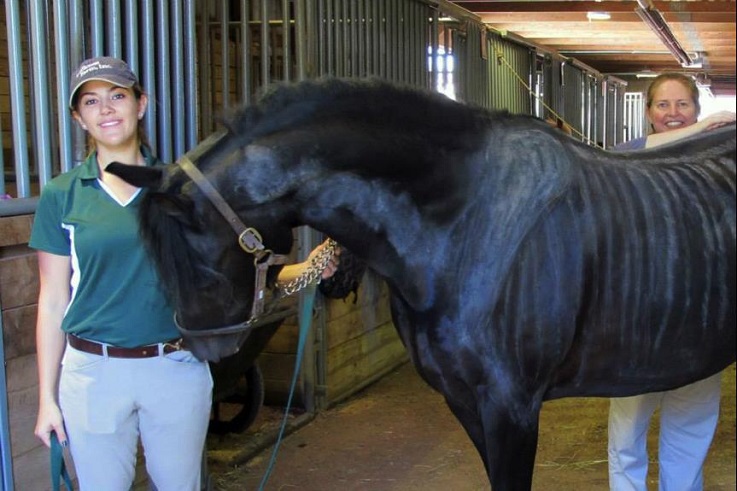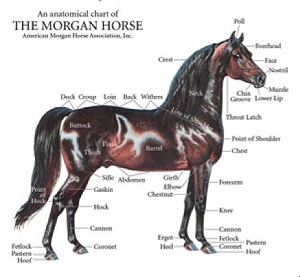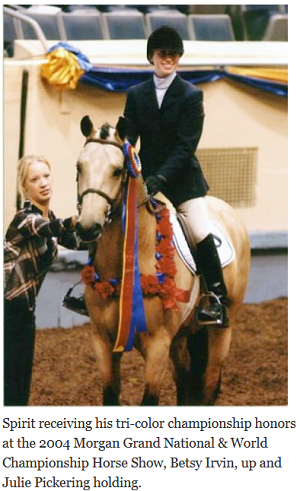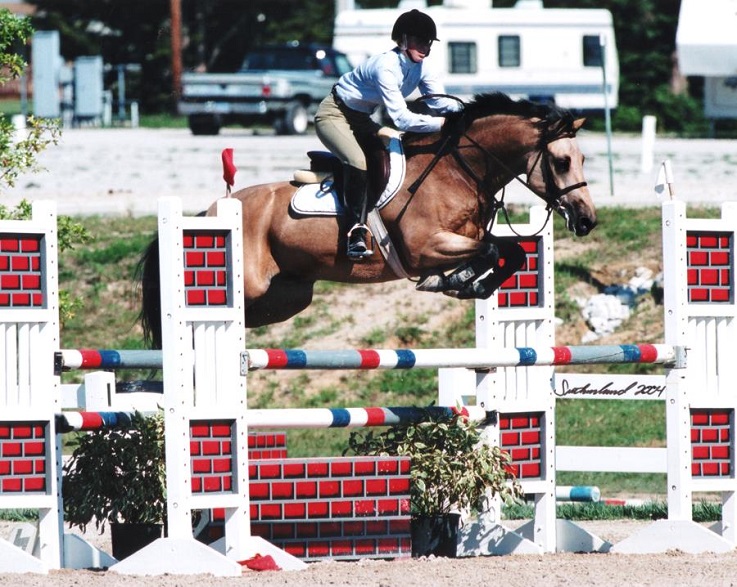The Morgan: Strong will, beauty and a little serendipity

Slick, a current Morgan on campus in the Western string sporting a chalk skeleton with student Victoria Berlin and Assistant Professor Laura Ward
Long before Laura Ward, William Woods University Assistant Professor of Equestrian Studies, had any horse experience, the Morgan was her favorite breed. She got her first Morgan in high school from a want ad in the Milwaukee Journal-Sentinel.
“Morgans were not easy to come by where I grew up in rural western Wisconsin, but somehow I stayed faithful. He was advertised as a horse that had been used in parades and that proved to be the perfect background for the adventures that we went on to have,” Ward explained.
A few years later, in Ward’s second year as an equestrian science student at William Woods, she befriended another student — a freshman — who had a Morgan background.
“Low and behold, my wonderful first Morgan had been bred at her family’s Merwin Morgan Farm sixteen years earlier! She was from Illinois, I was from Wisconsin and we met in Missouri. We became roommates.”
Ward’s first job after receiving a bachelor’s in equestrian science degree was at a Morgan horse training and breeding farm in southern Wisconsin. Ward has shown and judged Morgans for the last thirty years at the state and national level.
What Ward loves most about Morgans is their nature and their conformation.
“My observation of the Morgan attitude is that if something isn’t their idea it isn’t worth doing. If you come to a conflict of wills the human is not going to win. Therefore, you always have to figure out a way around an impasse before it even occurs. That being said, Morgans are pretty much up for doing anything with ‘their human,’” Ward said.
 Morgans have an arched neck, pretty head with large eyes and a body style that is short coupled and rounded in shape.
Morgans have an arched neck, pretty head with large eyes and a body style that is short coupled and rounded in shape.
Their form is that of the “artists’ horse” — animated, arched, thick mane and high set tail, the horse that is found with the hero in equestrian statues and in fine art through the centuries.
Morgans are a historical American breed established just after the Revolution in the New England area. They were a utility breed for riding, driving and work, and were relatively low maintenance. The most unique aspect of the Morgan is that all individuals trace back to a single foundation sire, the Justin Morgan Horse (1789 – 1821). Because this single sire was so dynamic, he was a popular cross for “your mare” regardless of her type or what you needed to use your horses for, says Ward.
The American Morgan Horse Association writes, “Lifestyles of early American families demanded their horses be useful and strong in the field and also quick and stylish harness and riding horses. The Morgan was a popular answer to these needs.”

This versatility shows in their ability to perform in every discipline. There have been Morgans represented in each of the four seats at William Woods University. Currently, the Saddle Seat and Western strings each have multiple registered Morgans, but the Dressage and the Hunter/Jumper strings have both had Morgans in the past.
One of Ward’s favorite Morgan stories involves a little buckskin that was donated to the Saddle Seat program — nicknamed Spirit, after the animated movie about the buckskin mustang.
Spirit receiving his tri-color championship honors at the 2004 Morgan Grand National & World Championship Horse Show, Betsy Irvin, up and Julie Pickering holding.
Spirit was not impressed with Saddle Seat or going around the arena to the sound of applause, but the Hunt Seat instructor at that time, Linda McClaren was watching him and said that she wanted to see him free jump.
“Jumping was just what “Spirit” needed to keep him out of trouble,” said Ward.
A student at the time, Betsy Irvin (now Guarino), rode him and trained him under McClaren’s guidance. During the course of his training they showed in all-breed USEF Hunter/Jumper competitions and even rode in a George Morris clinic.
 Spirit & Betsy Irvin at the St. Louis Charity Horse Show, 2004.
Spirit & Betsy Irvin at the St. Louis Charity Horse Show, 2004.
“Two or three years later, he won the title of World Champion Open Jumper at the Morgan Grand National & World Championship Horse Show, going undefeated in the three classes in his division.”

